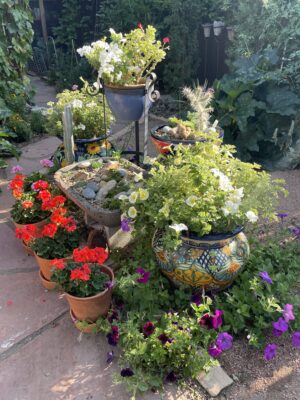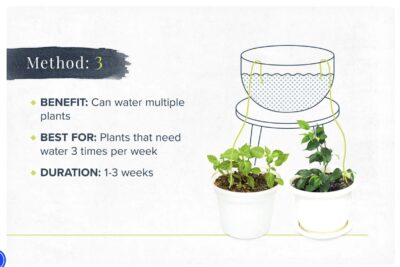Heat extremes, aka the Heat Dome, such as we’ve been experiencing this past month is not something any gardener would wish to entertain again. Weather conditions are always the no.1 topic of conversations having to do with horticulture, and, clearly, I’m no exception to this rule. Not only have the plants not tended within the airconditioned sanctum of my sunroom, withered in the heat that is exacerbated by our elevation in the Rockies. Even despite adequate watering, the beans and tomatoes melted like damsels wilting onto fainting couches, and turned my pale, once dewy, Irish skin to chicharonnes, that highly popular, crunchy snack food of Mexican origins.

Just as a quick shower at day’s end revives a torpid spirit, so a good post-sunset drink in the evening freshens the garden, helping plants to weather the next burst of solar heat. This tip I learned from my trusty garden companion, Phillip Miller and his month-by-month guide to garden tasks, titled The Gardener’s Kalendar; my cherished edition is the 16th, published in London in 1776..a (ahem) difficult period on both sides of the Atlantic. Mr. Miller writes in thing to be done in July:
“In dry weather, observe to water the plants as have been lately transplanted, and be sure always to do it in the an evening, for one watering at that time is of more service than three at any other part of the day…whereas when watered in the morning, the sun coming on soon after, the moisture is drawn up before it reaches the root; and where there is convenience. Lay mulch upon the surface of the ground about the roots of the plants.”

Another bit of cleverish advice comes from Mrs. Phillip Martineau in her rather romantically driven book of 1924, Gardening in Sunny Lands, The Riviera, California, Australia. Edith Wharton, a close friend of the author, wrote the introduction, speaking from her experience of gardening at her villa Sainte-Claire du Château in the hills above Hyères in the south of France. Even then, water was an issue, as Martineau writes:
“Should the water-supply at any time run very low and plants need water badly, an excellent plan is to fill with water a bottle, a jar, or can (according to the size of the plant), and stand it close to the patient, placing a thread of wool, or a small skein of wool as the case may require, in the bottle or jar, and leaving it to trail over the ground near the plant. The water will be soaked up by the wool, and will slowly and surely moisten the ground … in the case of some rock-plants which resent being alternately soused and grilled, it is essential.”
As I’m about to create a new rock garden, and this being in the Rocky Mountains, I take this advice very much to heart, especially the reference to “grilled” plants. It goes without saying this method could work in the greenhouse or on the patio, if irrigation is not laid on,as well as for houseplants in general.

©Ethne Clarke 2024










